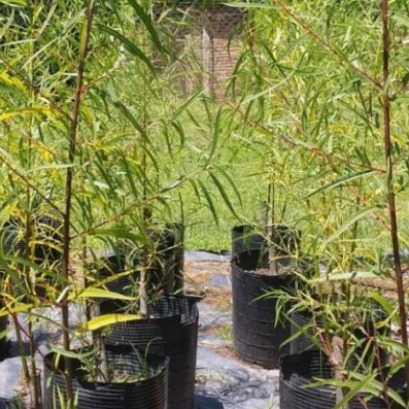
They discover how bacteria help trees to survive drought
A new study of the Weizmann Institute of Sciences revealed that microorganisms benefit cypresses to face water scarcity. The result provides tools against increasingly frequent climatic phenomena
When things get difficult, we all need a friendly hand, and trees are no exception. Researchers from the Department of Plant Sciences of the Weizmann Institute of Sciences have discovered that, in drought conditions, the cypresses receive help from the beneficial bacteria for the soil in a kind of cooperation that allows them to survive and even prosper. ?Our study could have provided the best evidence until the time that trees and bacteria can really coexist symbiotically, ?says Dr. Tamir Klein, head of the research team. This has enormous ecological importance, he adds. In many places in the world, the summer of 2022 was one of the driest stations registered. Some parts of China, Europe, the Middle East, the Horn of Africa and North America suffered severe droughts, and these extreme climatic conditions are expected to increase as a result of climate change. According to Klein, the growing prevalence of droughts creates an urgent need To understand the underground mechanisms that keep trees alive in extreme weather conditions, in order to mit carbon, clean the air and regulate the temperature. Therefore, we must support our forests. And if bacteria can support trees and we can understand how they do it, that is an excellent starting point, ?he explains. Kleins trip to reveal cooperation between trees and other forest organisms began years ago. In his previous studies, he investigated how trees share resources with other trees to stay healthy and how they maintain symbiotic relationships with fungi. The last study, led by Dr. Yarara Oppenheimer-Shaanan, Microbiologist of the Klein laboratory, focused on interactions Between the cypresses and the beneficial bacteria present in the forest floor. During a month, the researchers cultivated cypress seedlings in custom -made boxes full of forest land, which were placed in a greenhouse in the Weizmann Institute of Sciences. The cypresses were divided into two groups: one was watered regularly and the other was deprived of water. In each group, half of the cypresses were exposed to soil bacteria that had been collected from the Harel forest. The research team examined the interactions between the roots of the trees and bacteria using several methods, including the measurement of physiological reactions From trees to dryness, the realization of bacterial counts, obtaining images of the bacterial colonies in the areas of the roots using fluorescent markers, the analysis of the compounds issued by the seedlings through their roots and the evaluation of the Mineral composition of the foliage of the cypresses. Through this multidisciplinary approach, which combines microbiology, plant physiology and organic chemistry, researchers identified the surprising cooperation that occurs underground between trees and soil bacteria: bacteria They help trees in front of water scarcity and, in return, benefit from the secretions of the root roots. For example, the root secretion rate was more than double in the trees exposed to bacteria, Compared to the trees that were not, both in the group of irrigated cypresses and in the group that grew in drought conditions. In addition, scientists identified around 100 compounds in the secretions, including phenolic and organic acids, and concentration From almost half of these compounds, it differed significantly between irrigated trees and those who suffered lack of water. When we add nine of the compounds to bacteria, such as carbon and nitrogen sources, eight of them stimulated bacterial growth, says Oppenheimer-Shaanan. This is proof that secretions are a source of food for bacteria. In addition, during a drought, cooperation between trees and bacteria compensated for the negative impact of the lack of water. Phosphorus availability in the soil remained only for cypresses that were exposed to bacteria, and this availability compensated for the decrease in Phosphorus and iron levels measured in the foliage of cultivated cypresses in drought conditions. Klein expects the results of this research to advance our knowledge of forest ecology and the understanding that trees participate in much broader cooperation of what which was previously believed. At the level applied, the findings may have important implications to improve soil health and learn to support plants that are under stress due to lack of resources. For example, the recruitment of specific bacteria could help improve the health of trees and forests and generate greater ecological resilience and stability. ?The next step is to determine the exact contribution of each bacteria or each group of bacteria, and what bacteria They benefit what trees, says Oppenheimer-Shaanan. This is just the beginning. The more we learn about these interactions, the more capable we will be to formulate a complete and precise dictionary, and this should allow us to reach the desired results, or prevent the unwanted, in the care of our forests, ?concludes Klein.
IT MAY INTEREST YOU
 INTA Delta begins propagation of seven Creole willow clones for ecological restoration in Paraná
INTA Delta begins propagation of seven Creole willow clones for ecological restoration in Paraná
As a result of the rescue, domestication and registration work carried out by Teresa Cerrillo, a leading researcher in Salix Genetic Improvement, within the framework of the National Genetic and Forest Resources Programs of INTA, the multiplication and propagation of seven clones of Creole willow (Salix humboldtiana) began recently registered in the National Seed Institute (INASE) by INTA Delta del Paraná.
 Native forest | In Misiones, controls are tightened on routes for illegal transport of native wood, logging of forests without permits and fraudulent digital guides
Native forest | In Misiones, controls are tightened on routes for illegal transport of native wood, logging of forests without permits and fraudulent digital guides
Informality in forestry activity in Misiones was once again evident, the culture of operating illegally is a historical problem, and the Ministry of Ecology and Renewable Natural Resources carries out the corresponding control and inspection operations in the regulation of productive activity and sustainable management for the use of native forests.
 Combilift Unveils the 2025 Christmas video “Twelve Days of Christmas” – with a Twist!
Combilift Unveils the 2025 Christmas video “Twelve Days of Christmas” – with a Twist!
Monaghan, Ireland – November 2025





















